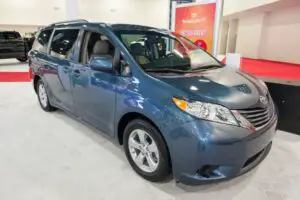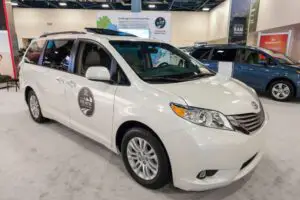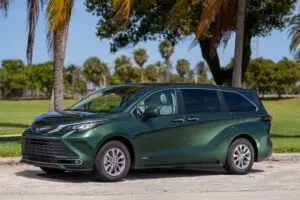Named after the Italian city of Siena, the Toyota Sienna was marketed primarily for North American and East Asian markets, being in production since late 1997 and still going strong to this day, becoming a very popular vehicle that a lot of people gravitate towards.
With so many people loving the vehicle, expectations are always set high, but unfortunately, now and then, one of the owners of the car will be forced to ask, “Why won’t my Toyota Sienna start?” and the answer could be a lot of issues; anything from the battery to the starter system.
Even the fuel system is not safe from suspicion when dealing with issues like this.
Here, I have listed the main issues which prevent the Toyota Sienna from starting:
- Bad Fuel Pump
- Alternator Issues
- Spark Plug Problems
- Dead Battery
- Dead Starter Motor
I will be going over all these issues in the article, so read it if you want to know everything about the Toyota Sienna.
Table of Contents
- 1 What Would Cause A Toyota Sienna To Not Start?
- 2 Frequently Asked Questions
- 2.1 Q1. Why Won’t My Toyota Sienna Start With New Battery?
- 2.2 Q2. Why Won’t My Toyota Sienna Start Even With A Jump?
- 2.3 Q3. Why Won’t My Toyota Sienna Start But Lights Work?
- 2.4 Q4. Why Won’t My Toyota Sienna Start But Cranks?
- 2.5 Q5. Why Won’t My Toyota Sienna Start Just Clicks?
- 2.6 Q6. Why Won’t My Toyota Sienna Start In The Cold Weather?
- 2.7 Q7. Why Won’t My Toyota Sienna Start After I Get Gas?
- 2.8 Q8. Why Won’t My Toyota Sienna Start But Radio Works?
- 3 Conclusion
What Would Cause A Toyota Sienna To Not Start?

As mentioned above, there are quite a few reasons your Toyota Sienna may not work.
While the situation may seem grim, you will be glad to know that you won’t be replacing your car any time soon.
Instead, you can isolate and fix the problem and have your car start as good as new.
1: Bad Fuel Pump
The car’s fuel pump does what the name suggests; it pumps the fuel from the gas tank to the engine, allowing it to combust and start the engine.
You should be able to see the drastic effects of a defective fuel pump; no fuel enters the engine, making it impossible for the Toyota Sienna to start.
This will, in turn, lead to a loss of power in the engine, making it difficult for the car to start.
This may also force the check engine light to turn on. Stalling will occur at high temperatures, and eventually, the car will not start.
If you are under the impression that your fuel pumps are not working properly, you should visit a mechanic as soon as possible as it will be difficult to assess the situation yourself.
What Should You Do About It?
- The logical choice to remedy a faulty fuel pump is to replace it entirely.
- Take your Toyota Sienna to the mechanic and have him/her work on replacing the fuel pump.
- Fixing the fuel pump is not advised as it is more trouble than what it’s worth and may cost a lot of money.
- Make sure to change the fuel filters from time to time.
- You should also use high-quality fuel with less dirt, grime, and contaminants.
2: Alternator Issues
If you are the owner of a Toyota Sienna, then chances are that you have probably dealt with alternator trouble.
An alternator is an essential part of the car as it is responsible for charging the battery of the car.
It does this by converting the mechanical energy generated by the car into electrical energy.
Almost 27% of the time, the car does not start because of issues in the alternator, which is a surprise to hear since alternators rarely go bad.
If there are issues in the alternator, you will see a drop in charge in your battery which will be evident in voltage tests.
Diagnosing the alternator may be difficult if you do not know what you are doing, as many people often attribute alternator problems to battery issues and end up replacing a perfectly good battery.
What Should You Do About It?
- Jumpstart the Toyota Sienna and run a voltage test on the battery. If the engine’s voltage is less than 13.5V, then the alternator is at fault.
- Plan a trip to the mechanic and get a replacement alternator for the Toyota Sienna as soon as possible.
- Once you have a new alternator, you should take steps to maintain it for the rest of its natural life.
- You can regularly clean it with engine degreasers and compressed air.
3: Spark Plug Problems
The average Toyota Sienna uses four iridium spark plugs, which should last up to 120,000 miles. (Also, learn about the life expectancy of your Toyota Sienna).
Once you have reached this point, you should replace them to prevent engine damage. More importantly, you should have them replaced if you want to continue being able to start the car.
If you are running defective spark plugs beyond use, your car will not be able to the spark necessary for the ignition to start the combustion process.
Regardless of how much fuel you have and how charged your battery is, if the car cannot create a spark, then it will not start.
Fouled spark plugs are a common reason why some cars will not start.
As the electrodes get worn down, the voltage required to ignite the fuel starts to increase, leading to prolonged cranking and eventually the engine not rotating.
What Should You Do About It?
- Once you have figured out the issue is due to a defective spark plug, it is time to visit the mechanic.
- While it is possible to replace the spark plug yourself, it is recommended to have it done by experienced professionals.
- Once the spark plug has been replaced, you should ensure everything is in order and plan to prevent further issues.
- You can do this by regularly cleaning the spark plug and the surrounding area.
4: Dead Battery
The most common reason why any car does not start is the battery. Everyone’s first instinct when their car does not work is to check the battery.
And this is a justified reaction when you find out that nearly 40% of all Toyota Sienna that have had starting problems had issues related to the battery.
The battery plays the most important role in the entire car, which is why any problems should be eliminated immediately.
When you attempt to start the engine, the car may crank very slowly or not at all.
Eventually, you will start to notice that certain lights and accessories of the car are working properly, but the car itself cannot start.
The battery can easily be degraded if not given the proper attention it deserves, which is why you need to make sure that you develop habits that will prevent the battery from losing charge and retain its health.
What Should You Do About It?
- Conduct a voltage test to see the health of the battery. If the display shows less than 12 volts, you should consider getting a replacement battery as soon as possible.
- You can also attempt to recharge the battery by jumpstarting it using another car with a healthy battery.
- From now on, use your car in moderation to keep the battery from losing charge; not too many long trips, and avoid keeping it stationary for too long.
5: Dead Starter Motor
Generally, starter motors rarely go bad and can last a very long time, which is why many people do not think to worry about them, but this is not the case for Toyota Sienna owners, who found it pretty common for their starter motors to fail.
Many of them found this the hard way when they turned the key and heard the starter solenoid click but the engine not rotating.
A solenoid failing is quite common for the Toyota Sienna, and if this occurs, it will be very difficult for you to start the car.
You will have to replace the starter’s solenoid as fixing it is simply too expensive. The starter itself could have also worn out over time and malfunctioned.
If you turn the key and nothing happens, then there is a high chance that the starter motor is the culprit, and once again, you will have to replace it with a new one.
What Should You Do About It?
- Listen for clicking and whirring to determine if the issue is with the starter or not.
- Once you have confirmed the issue with the starter, you should visit the mechanic at your earliest convenience.
- Have the mechanic swap the old and defective starter for a new one.
- To ensure that such a problem does not arise again, you need to ensure that the starter does not overheat.
Frequently Asked Questions
Q1. Why Won’t My Toyota Sienna Start With New Battery?

If you have just gotten yourself a new battery and are having issues turning over your car, you should ensure that your newly purchased battery has been installed properly.
Look for severed connections or loose cables. On the off chance your battery installation was done wrong, you should visit a mechanic and have it installed properly.
If you were experiencing starting issues prior to replacing your battery, you might want to look into the fuel and starter systems of the Toyota Sienna since the battery is obviously not the issue.
Q2. Why Won’t My Toyota Sienna Start Even With A Jump?
Jumpstarting your Toyota Sienna will only make it start if the issue lies in a dead or low-charged battery.
While this is mostly the case when you have trouble starting the car, there are instances where the battery may not be the issue.
You should then check for faulty or defective components in the starting system of the car. If everything is good, then you should do the same for the fuel system.
Q3. Why Won’t My Toyota Sienna Start But Lights Work?
Sometimes, the battery may not have enough juice to properly start the Toyota Sienna but may have enough to power the lights.
Carry out a voltage test and see if the battery is the root cause.
If this is not the case, then you should carefully locate the issue, either in the starting system of the car or in the ignition system.
Q4. Why Won’t My Toyota Sienna Start But Cranks?
If your Toyota Sienna is cranking, you should be able to assess that the electrical and the starting system of the vehicle are all working fine.
This means that the issue is likely within the fuel system of your car.
The issue is likely that the engine is not getting enough fuel, so there may be some blockage or a defect in the fuel system, which is preventing the engine from getting adequate fuel.
Q5. Why Won’t My Toyota Sienna Start Just Clicks?
You should assume that the issue is within the electrical system of the Toyota Sienna, which is preventing it from starting properly.
You should start by checking the battery for any defects and then move to either the starter motor or the alternator, as any of these components may be causing the issue.
Q6. Why Won’t My Toyota Sienna Start In The Cold Weather?
The cold weather starts to reduce the rate of reactions happening within the battery, making it difficult to start the Toyota Sienna.
Furthermore, it also causes the oil to thicken up inside the car, forcing you to get it flushed out and changed. You should protect your car from the cold weather whenever possible.
Q7. Why Won’t My Toyota Sienna Start After I Get Gas?
It is true that without fuel, you have no hope of starting your car, but if you have just added more fuel and your car is still not working, then you should check to see if the engine is even getting that fuel or if it is being halted by a defective component.
Once this is done and the problem is still not found, you should carry out a full diagnosis of your Toyota Sienna, checking everything to locate the issue.
Q8. Why Won’t My Toyota Sienna Start But Radio Works?
The radio of the Toyota Sienna starts by drawing power from the battery, which also starts the car itself.
In the event that the car is not starting but the radio is working fine then you might have a depleted battery on your hands.
If you jumpstart the car and the issue is not resolved, then be sure to check the battery and cables for corrosion and wiring issues as that could also be the problem.
Related: What Are The Worst Years For The Toyota Sienna?
Conclusion
The Toyota Sienna has proven time and time again that Toyota as a company is very talented and knows what they are doing.
The people behind this car are extremely capable and know exactly what their customers want, but unfortunately, no one is perfect, and every now and then, the customer will be forced to ask a mechanic, “Why won’t my Toyota Sienna start?”.
Now that you have finished reading this article, you should have a good idea as to what might go wrong with your Toyota Sienna and what you should look into if you want it fixed.

I am Tahir Azam, and I have been writing amazing articles for TaxiHack for as long as I can remember. I know everything that is to know when it comes to automobiles and is always on top of industry news and developments. While I am not an expert by any means, I pride myself on knowing the ins and outs of many different problems and, of course, their solutions. The articles on our website are some of the best and well-researched content that you will find, and I spend countless hours making sure this remains to be true. This is why I ask you to take your time out and read some of my articles, especially if you find a topic that resonates with you or is something you are looking into. This way, you will find the perfect mix of information and tips on your desired topic. Learn more about Tahir.



